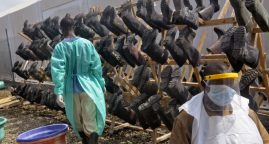OCHA report : 2017 Humanitarian Response Plan End of Year Report (January – December 2017)
Article published on reliefweb website on december 2017
Humanitarian needs remain staggering in terms of scale, severity and complexity:
Against the continued backdrop of high levels of violence and systemic violations of International Humanitarian Law (IHL) and International Human Rights Law (IHRL), no amount of humanitarian assistance and protection services can offset the lack of a political solution.
The scale of displacement continues unabated:
For every one person who spontaneously returned in 2017, there were approximately three new displacements. As hostilities in certain areas of Syria continue to drive mass displacement, humanitarian partners will continue to highlight that the overall conditions for safe, dignified and sustainable returns are not yet in place in Syria while ensuring that the response to spontaneous returnees continues to be consistent with core principles that support voluntary returns as a durable solution. A coherent response to the needs of IDPs and returnees based on humanitarian and protection principles will be paramount in 2018.
The Centrality of Protection:
Hostilities remain the principal cause of Syria’s humanitarian crisis, resulting in countless deaths and injuries, mass internal displacement, lost livelihoods and deepening poverty and erosion of coping strategies with the most vulnerable segments of the population such as children, youth and women particularly affected. In this context, responding to protection needs should remain a priority in 2018. Protection considerations and principles need to remain central in the humanitarian response and actors providing protection services need to be supported throughout Syria.
Predictable humanitarian funding remains essential:
With only 51.6 per cent of the 2017 Humanitarian Response Plan (HRP) funded for the year based on funding reported through the online Financial Tracking Service (FTS), humanitarian partners have prioritized – access permitting – helping those people in the most severe need who urgently require humanitarian life-saving and lifesustaining assistance. Underfunding in 2017 had a number of consequences, with an estimated 100,000 people not receiving life-saving and life-sustaining medicines for every US$1 million not mobilized in 2017. In general, underfunding prevented partners from adequately scaling up sustainable service delivery, and had a particular impact on livelihood interventions, with only 25 per cent of target beneficiaries reached with livelihood assistance in 2017. Continued under-funding will likely interrupt humanitarian life-saving assistance programmes, adversely affecting the ability of humanitarian organizations to reach these people. In this context the support of member states will remain essential in 2018 to i) make effective all pledges and ii) increase their financial commitment to principled and coordinated humanitarian action in Syria. At the same time, systematic reporting through the FTS is essential in informing a comprehensive analysis of funding gaps which can inform gap identification and help address critical, unmet needs.
Humanitarian presence, access and reach face extraordinary barriers:
Although humanitarian partners continued to prioritize assistance to people facing the most severe needs, a combination of active hostilities, shifting frontlines, administrative impediments and deliberate restrictions on the movement of people and goods by all armed actors often precluded sustained access to those in the most desperate need. The support of member states, particularly those with influence over armed actors, will remain fundamental in enabling the unimpeded provision of principled humanitarian assistance to people in need. The coherent and complementary use of various operational response modalities will remain key to ensure an effective, appropriate, safe and timely response to the most severe needs identified in Syria.
Humanitarian analysis and prioritization continues to be required:
Amidst a challenging funding environment and given the scale of needs in Syria, continued analysis remains essential to ensure humanitarian aid reaches the most vulnerable people in communities facing the most acute needs. In this vein, efforts to provide granular community-level information on needs, a comprehensive breakdown of response efforts and detailed gaps analysis at the Whole of Syria (WoS) level will need to be pursued in 2018 to support informed humanitarian policy-making, facilitate a common understanding of the humanitarian situation and to support targeted interventions.
Quality Assurance Efforts remain essential:
The quality of the response is underpinned by a shared commitment among humanitarian partners to various response standards. Ensuring appropriate mechanisms through which affected people can provide feedback on the adequacy of humanitarian initiatives will remain essential in ensuring that the needs and concerns of beneficiaries guide the overall response of the humanitarian community in Syria.
Efforts to enhancing resilience must be pursued along live-saving assistance:
With the crisis in Syria now entering its seventh year, there is a need to reflect on the parameters of the response inside Syria. Efforts should be made to explore improving the resilience component of the response, along life-saving efforts, to mitigate aid dependency and enhance community capacity in those areas of the country conducive to the implementation of more sophisticated programming, whilst continuing to prioritize the delivery of life-saving assistance to those in most urgent need.
Related Articles
Leading medical organizations team up to bring new TB treatments to those in need
03/19/2015. International organizations Partners In Health (PIH), Médecins Sans Frontières (MSF), Interactive Research and Development (IRD) and their financial partner UNITAID will start in April the endTB project, a partnership aimed at radically changing the management of multidrug-resistant tuberculosis (MDR-TB).
US foreign aid cuts: what could impact be?
04/28/2017. A leaked State Department budget document lays out proposals for a 30.8 percent cut in development aid and plans to sharply cut back.
In Defense of Philanthrocapitalism
12/21/2015. This article published in “The New Yorker” reported on this new trend appeared in the US a few years ago. Explanations …




